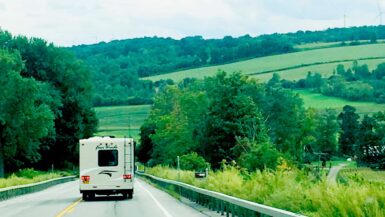
Anytime we have the opportunity to travel as a family, we are making lasting memories of fun and adventure. However, one of my favorite benefits of homeschooling is the chance to take a homeschool travel approach to the trip and capture the opportunity to learn on the road.
My husband travels a lot for work, and when it makes sense, it’s great to tag along with a homeschool travel focus. We also have family all across the country that we like to visit when we can. As a homeschooler, I recognize that there are so many hands-on learning opportunities that we can take advantage of when we’re “in the field” and planning our trip with a homeschool travel approach.
For example, we turned our recent tag-along trip to Jackson Hole, Wyoming into a spontaneous “field trip” — complete with a unit study and scientific/historical tour. I put together a Wyoming unit study using free resources on the Internet and picked up a few helpful books at the library so we could make the most of learning opportunities while on the road. If you’ve never considered using a unit study approach to maximize activities that you already plan to do, here are my tips for creating a unit study on the fly.
We visited the historical sites in town and toured the Jackson Hole Historical Society & Museum. We were also staying in a historical hotel, The Wort Hotel, which had its own collection of splendid art on display and historical photos adorning the halls. What a treat!
Our science and nature study segment took place in the Grand Tetons National Park. We had the opportunity to see abundant wildlife roaming quite close to the roads and pull-outs as we drove through the park. We saw a large herd of bison roaming with many new calves at their sides. We also saw families of trumpeter swans with their little gray signets swimming close by. We even saw several pairs of moose traveling together through the willows near the road. The enormous elk herd grazing in the nearby elk refuge was a spectacular sight as well.
The Concept of Homeschool Travel
It took me a couple of years of adjusting to the homeschooling life to realize that homeschooling is about so much more than cracking open curriculum at the dining room table everyday. It’s an opportunity to develop a lifestyle of learning for your family. To me, a lifestyle of learning means recognizing that life itself presents countless learning opportunities.
My homeschooled husband was fortunate to have experienced a lot of hands-on homeschool travel with his family, learning on the road while his parents traveled across the country. His sister Rosanna (a fellow contributor to our NextGen Homeschool blog) shared a glimpse of what homeschool travel was like for them and what she loved most about the experience in this post on homeschool travel. My husband’s experiences as a homeschooled student traveling with his parents had a lot to do with my excitement about incorporating travel into our homeschooling plans for our three girls.
These four steps have been essential for me when planning a homeschool travel experience:
Step One: Think Like a Homeschooler
When you approach any subject as a homeschooling teacher, what do you take into consideration? What do you find works best for your child to learn and then apply new knowledge and skills? These same strategies will help you plan how to maximize learning opportunities when you are traveling.
Although museums and traditional venues for “experiencing” a new location are helpful, don’t stop there. Take your children’s learning styles into consideration. Would a dramatic performance excite them? Seeing a local art gallery? Hiking or biking through the town and surrounding area? Taking a guided tour? Meeting a local who provides their own unique point of view?
Once you have some ideas for how you can incorporate educational experiences into your trip, it’s time for research.
Step Two: Research & Plan Your Adventure
The Internet has made it so much easier to plan for any type of travel! Once you have a list of ideas, you can Google all of them and see what pops up. You can get museum schedules, locations, prices, nearby restaurants… and you’ll never feel lost or unprepared.
However, I would suggest you don’t limit yourself to what you find online. Not every worthwhile experience is captured on an Internet search engine. Do you know anyone who lives in the area? If so, can they give you suggestions? What are their favorite ways to experience their town?
There are also good old-fashioned books at the library. We found some wonderful books about Wyoming from different perspectives before our trip, and we also checked out a few historical fiction books about life in Wyoming that added richness to the experience of visiting there. Think outside the Internet box when you’re putting together your travel plans and gathering resources for your children.
Step Three: Make a Budget
It’s no surprise that homeschool travel means adding an expense to your family budget. Gas, lodging, food, entertainment… you name it, and it costs something! So if you would like to include travel in your homeschooling plans, you’ll need to budget for it in advance as accurately as possible.
One approach to budget-friendly homeschool travel is to go to places with a purpose. If you have family or friends there, you may be able to minimize costs by staying with them and eating home meals. If you have business there, some expenses may be reimbursed or tax deductible. Tag-along travel, as I like to think of it, can save money while still providing a wonderful “field” learning experience for your children.
If it’s a trip planned purely for family adventure and education, you will need to look into all of your costs in advance and make a plan. My family loves camping, so we can save money on lodging as long as we travel during favorable weather. Check the local chamber of commerce to see what’s taking place in the area that is free: Festivals, town events and other sponsored activities abound that can provide learning and entertainment for little to no expense. Hiking and nature observation is always free!
My point here is to be creative and out-of-the-box about what these trips will look like. Homeschool travel does not have to be a lavish, Disney vacation. It’s about being in the field and experiencing the world instead of reading about it. In fact, you’ll probably learn more when you’re traveling off the beaten path. There’s more to a town than tourist attractions!
Step Four: Equip the Family for the Adventure
To make the most of your homeschool travel, you may want to create a unit study or another organized “lesson” in advance to take with you for capturing the experience. If unit studies appeal to you, here are my tips for creating a unit study on the fly. Many ready-to-go unit studies are also available for purchase. They are a wonderful organizational tool for capturing what your children are learning on the road.
However, I think the most essential tools for the homeschool travel toolkit are a notebook, a camera, and art supplies (crayons & colored pencils). Binoculars are also great when you plan to observe birds and wildlife. If your children enjoy sketching, a drawing pad or blank journal (with white pages instead of lined paper) is also helpful. Personally, I like to bring at least one folder with pockets to store all the “extras” we pick up while on the road (flyers, brochures, stickers, etc.).
If you have readers, checking out several books in advance to read on the road will help your children stay engaged in the locale and answer many questions they might have along the way. Regional or cultural music and audio books can also be checked out in advance for the trip if you have auditory learners. If you have a “collector” in your family, make sure he or she brings an extra bag for the rocks, flowers, postcards, coins and other memorabilia that might be collected on the trip.
Creating a Lifestyle of Learning
The idea of planning travel for the purpose of homeschooling may still be daunting for you. If your children aren’t yet at an age that learning on the road is feasible for you, don’t rush it — they won’t always be little! If budget or time off work is a constraint, think smaller scale: Where can you go on a day trip that will be exciting and educational? Can you join up with another homeschooling family and do something together?
No matter what you do outside the home with your family, it’s an opportunity to reinforce a lifestyle of learning for your children. Whenever you have the chance to venture outside the home, outside your town and your comfort zones, there is something new to learn and share. It may not be postcard perfect — but that’s a good thing!
I think the more we can help our children engage in the world outside the walls of home, the better. After all, the great commission of Jesus is to go into all the world to share the gospel. Homeschool traveling may be just the beginning of a far-reaching story of ministry for your family!
Do you ever get a chance to incorporate travel into your homeschooling plans? Have you had the chance to homeschool abroad? What other ways do you incorporate learning outside the “classroom” of home?
Renée Gotcher is an entrepreneur, writer, wife & home-educating mother of three daughters: Audrey, Claire and Elise. Renée was homeschooled during her last two years of high school and started homeschooling in 2010. A former journalist, she is currently the editor of NextGen Homeschool and blogs on personal topics at A New Chapter . Her family lives in Castle Rock, Colorado.
Photo from www.freedigitalphotos.net By Poulsen Photo, published on 14 February 2012 Stock Photo – image ID: 10072884






Be sure to allow time off for birthdays, holidays, vacations, and your designated breaks. In The Well Trained Mind, by Susan Wise Bauer [Peace Hill Press, 1999] parents are advised to consider deeply the implications of choosing school breaks. Traditional schools are off for some combination of 12 weeks in the summer, but homeschoolers have the luxury of choosing to be “off” whenever they want. In Bauer’s family, they’ve chosen April, August and December. Attempting to “do school” in December, she explains, was difficult with all of the holiday shopping, preparing, and volunteer work. Planning family vacations in June and July meant paying peak prices for everything because that’s when every other kid in the country would be traveling.
Great points Rosella — thanks for sharing them! We also take time off throughout the year and don’t take a three-month summer break. It’s nice to be able to schedule our school around our family priorities and the flow of life.
Renée at NextGen Homeschool